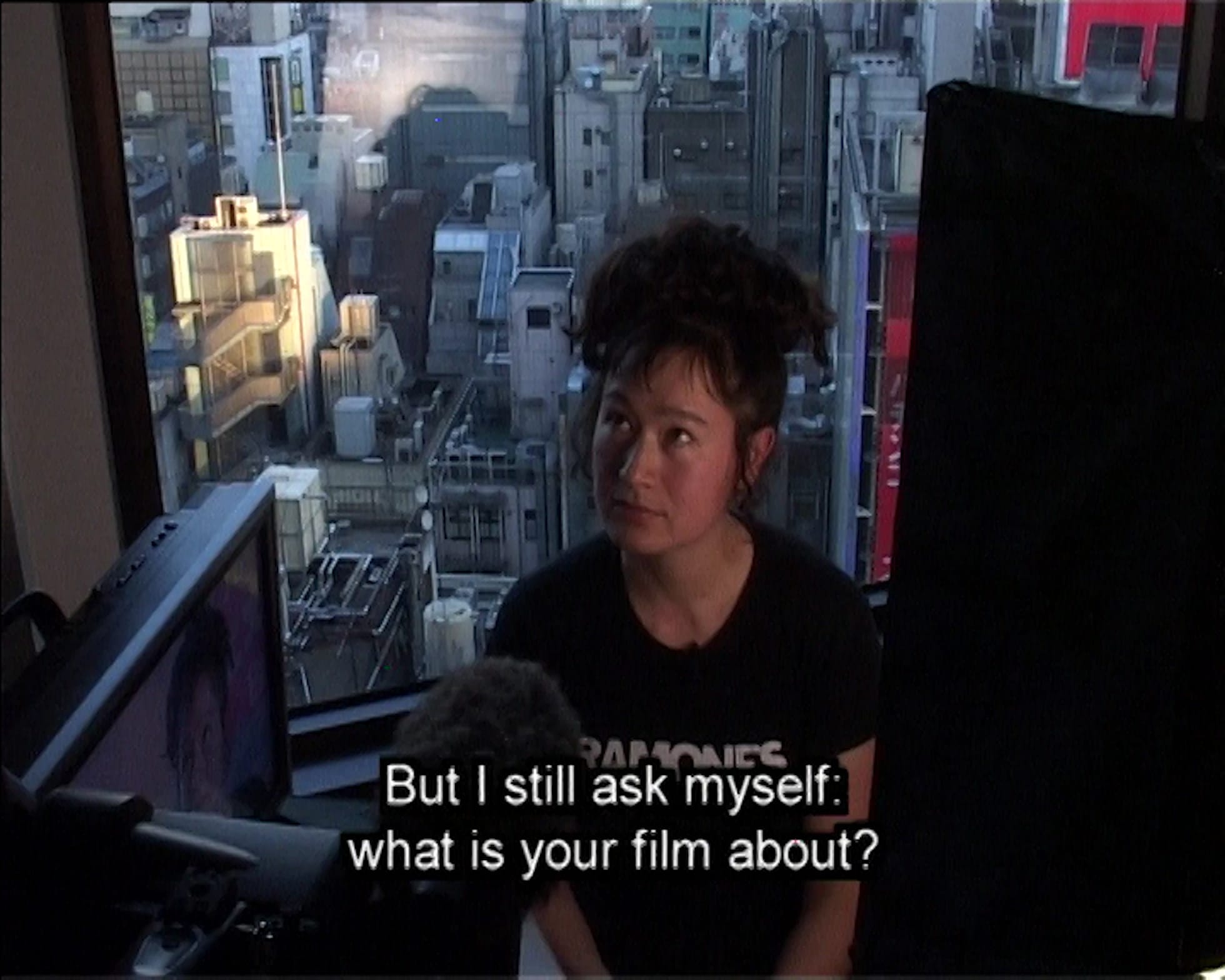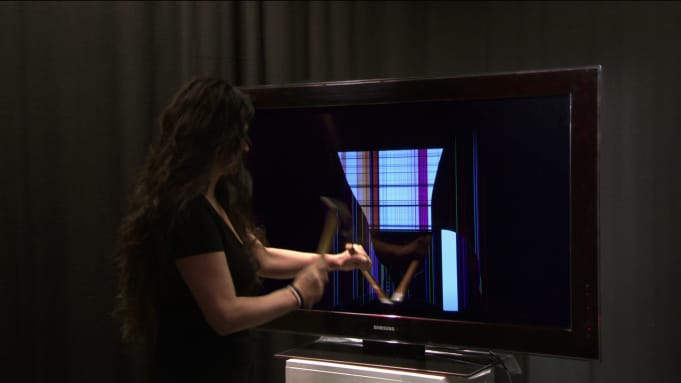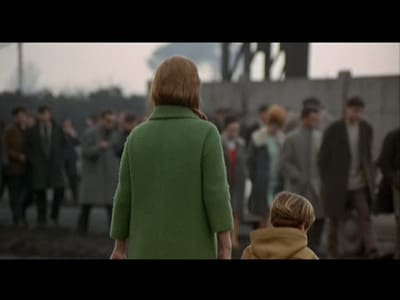Hito Steyerl, Lovely Andrea, 2007. CC 4.0 HITO STEYERL/COURTESY THE ARTIST, ANDREW KREPS GALLERY, NEW YORK, AND ESTHER SCHIPPER, BERLIN
When filmmaker Harun Farocki died in 2014 at age 70, his loss was felt deeply throughout the art world—and far beyond it. But perhaps no one responded with more passion to his passing than artist Hito Steyerl, who has described the German filmmaker as her mentor. In an e-flux essay called “Beginnings” that she dedicated to him, she wrote, “From Berlin to Beirut to Kolkata, Mexico, Gwangju, and wherever airlines and wi-fi travel, Harun’s work struck a chord and brought people together: from Straub and Huillet nerds to Tumblr impressionists and drone opponents. From West Berlin to the West Bank. From salon bolsheviks, dialup activists, and SketchUp gallerinas. From portable film clubs to mobile phone browsers.”
Somehow, until right now, nobody had properly surveyed Farocki and Steyerl’s work together. At Galerie Thaddaeus Ropac in London, through April 4, is a show that does just that, placing some of the finest films and videos by both artists in close proximity to each other. The two share a concise set of interests and artistic approaches. Both consider an increasingly violent and interconnected world that is being altered by new kinds of moving-image technology, and they weave together seemingly unlike events and ideas, coolly delighting in the phantom threads they find along the way that cross national and ideological borders. To hear more about Farocki’s impact, earlier this week, ARTnews conducted an email interview with Steyerl, who in June will have a major mid-career survey at Paris’s Centre Pompidou.
ARTnews: This exhibition is one of the first major ones to properly survey your output alongside Farocki’s. How would you describe your time with him? What did you learn from him?
Hito Steyerl: I recently found a short phone video showing Farocki a couple weeks before his death holding a workshop for children. The kids were super excited and loved it. Harun was able to explain very complicated things to all sorts of people in an entirely non-condescending, inspiring, and funny way. This is also one of the defining qualities of his work as a whole.
Both your videos and Farocki’s films rely heavily on narration, often using it to lyrically string together seemingly isolated images and ideas. What interests you about the essay film format?
Historically, the essay was a dissident medium mixing different genres. Today it is even more conflicted because the mix of fact and fiction is one of the main tools of contemporary political manipulation. Misinformation and conspiracy theory are just two examples. So, the essay [has] been dragged into the thick of things to become a major site of contestation. As a response, there is a new lease on realism, to safeguard veracity, facts, reality, etc. But there is another question which is usually overlooked: how about poetry? Literature? Is Shakespeare fake news? Is Ursula LeGuin conspiracy theory? It seems that one not only has to defend facts, but maybe fiction has to be defended equally rigorously. It is a fact that telling fictional stories does not necessarily equal lying. So, while the assault on facticity erodes civic life, trying to mitigate the situation by minimizing fiction erodes art. The essay unfortunately sits on all these major lines of conflict. Saying this makes me want to immediately take a Bob Ross tutorial.
In Farocki’s 2006 work Workers Leaving the Factory in Eleven Decades, he explored filmed images of workers exiting factories—which have pervaded the medium almost since its very beginning. Why do you think he viewed labor and cinema as being so interconnected?
In German, the term montage is applied to workers traveling somewhere to build or fix some production machinery. Montage, or editing, historically evolved as a way to streamline production cost based on the principle of the conveyor belt. Today, this labor has shifted to include the spectator in terms of having to pay attention or, more generally, to scramble to create themselves as products or brands.
In your own work, you reinterpret Farocki’s theories about labor for the digital age. In your 2010 work Strike, which shares its name with a Sergei Eisenstein film about a workers’ revolution, you take a chisel to a flat-screen monitor and render it unusable. Has the relationship between labor and cinema changed at all with the advent of digital technology?
Of course. The traditional factory is no longer the general model for image-making. On the one hand, there are unpaid freelancers making images, and on the other hand the big platforms almost fully control their impact. There is a funny scene in one of Harun’s early films: a guy steals some of the parts he makes at his factory and tries to assemble a vacuum cleaner at home. But he always gets a machine gun as a result. Likewise another tries to assemble a machine gun, but all he gets is a vacuum cleaner. Maybe today, if you make images and run them through a platform the results will be similarly unpredictable. You try to make a meme, but you discover your face was stolen and is now held hostage by someone threatening something. In fact, the probability for this is 100 percent.
Another theme you have returned to frequently is the direct connection between war and moving-image technology. Is it possible to envision a form of filmmaking that isn’t in some way violent?
Good question. I don’t think filmmaking could be disentangled from whatever digital technologies are entangled with, which is a lot of things today. But right now, for me, the question is rather that there seems to be a huge push for automation, both of filmmaking but even of spectatorship. Some sort of machine cinema in which even the spectators are machines. It’s kind of a relief, too—one can just go outside and hopefully enjoy the day.
In your e-flux essay about Farocki, “Beginnings,” you mention that, in his film On the Construction of Griffith’s Films, “cinema is now rephrased as architecture.” In your work, you have sometimes literalized this—you have made screens that show your videos as part of architectural settings, as you do in The Tower, in which viewers watch your videos in stylized armchairs that correspond to the red carpeting around them. Why do you and Farocki so frequently situate moving-image works in architectural settings such as this?
As the cinema got dispersed, so did its architecture. The screen is one thing in cinema, but there is also darkness, chairs, speakers, the offscreen. Most of that got left behind when moving images started to migrate, so one would have to reimagine it. The offscreen especially is quite diminished and pushed toward the back end.
In an interview with Farocki from 2011, he told you that documentary filmmakers had found a home in the art world. Why do you think the art world has become so acceptant of documentary filmmakers, in a way that, perhaps, the film world has not?
There were more different economies in the art world. The film and TV world had become very streamlined for profitability, so experimentation was pushed to DIY activities and reality TV replaced documentaries. The art world was more of an uncoordinated mess. This has been changing a lot in the last decade—the format that seems to emerge looks more as if art were successively integrated into larger hospitality and experience conglomerates/filter bubbles.
In that same interview, you said that film history is taking place on YouTube now. Do you still think that this is the case? If so, why? If not, where is it taking place?
I think this era of YouTube ended when a woman walked into its offices a while ago and killed herself and two others because a change in the algorithm had suffocated her income. The internet of the early 21st century has been dead for quite a while now. Film history, now, is probably warming the planet through streaming services, which are exponentially contributing to global energy consumption. What used to be the poor image, an itinerant low quality image stumbling through modems, is now an image whose power, impact, and reach is reflected by electricity expenditure, carbon emissions, and the resource wars around this. A power image, so to speak.




